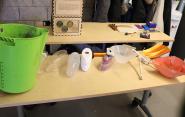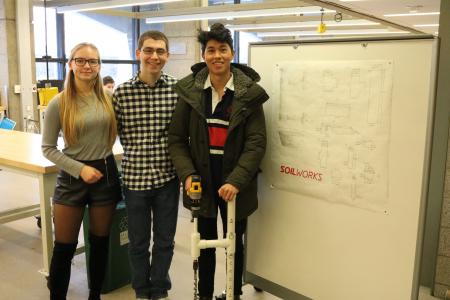From Ancient Chinese Mirrors to Soil Collecting, Students Demonstrate Their Innovations

Innovations abounded this semester in the John Klingenstein '50 Design Lab at the Center for Engineering Innovation & Design (CEID).
Students in Engineering Innovation & Design (ENAS 118) turned their problem-solving skills to soil collecting and analysis, the ancient mirrors of the Han Dynasty, hand-washing for pre-schoolers, the ankles of Michelangelo’s “David,” and a better way to practice lacrosse. Taught by SEAS senior research scientist Larry Wilen and SEAS Deputy Dean Vince Wilczynski, the course tapped the expertise of faculty and staff from numerous disciplines throughout Yale. For each of these projects, the student teams worked with their clients, the people who encounter these issues regularly, and simply need a better way to approach them.
Here’s the first part of our round-up of this year’s projects:
Ancient Chinese Mirrors
 Working with a senior conservator at the Yale University Art Gallery (YUAG), the team of Alicia Kacharia, Eric Elftmann, Alex Cade and Zach Taylor, developed a way to explain the phenomenon of ancient Chinese mirrors from the Han Dynasty. So mysterious that researchers are still looking into their properties, the bronze plates appear to become transparent when bright light shines onto them. When the light reflects from the mirror onto a wall, a pattern on the back of the mirror appears.
Working with a senior conservator at the Yale University Art Gallery (YUAG), the team of Alicia Kacharia, Eric Elftmann, Alex Cade and Zach Taylor, developed a way to explain the phenomenon of ancient Chinese mirrors from the Han Dynasty. So mysterious that researchers are still looking into their properties, the bronze plates appear to become transparent when bright light shines onto them. When the light reflects from the mirror onto a wall, a pattern on the back of the mirror appears.
They’re a part of the newly reinstalled Ruth and Bruce Dayton Gallery of Asian Art at the Yale University Art Gallery. One of the problems with the objects, though, is that corrosion has dimmed their shiny, mirror-like surfaces considerably. On their own, the magical properties of the mirrors isn't immediately apparent.
“The big question is, how can we help our museum visitors better understand?” asked Carol Snow, deputy chief conservator and Alan J. Dworsky Senior Conservator of Objects. “What were they made of, how were they made, and how were they used? What did they look like when they were new?”
Answering that challenge, the students created shiny new replicas of the mirrors to show how they aged (vinegar does a good job of condensing centuries’ worth of aging into one month). They also designed a projector with a light source to demonstrate the mirror’s magical properties in action.
Soil Collecting and Testing:
Collecting dirt may not seem so complicated, but doing it properly requires skill and the right technology.
Needing a better way to collect and test soil samples, Charlie Bettigole, Program Director for the Ucross High Plains Stewardship Initiative (UHPSI) at the Yale School of Forestry and Environmental Studies, turned to the students of ENAS 118. With an increased interest in soil carbon as a way to offset carbon losses elsewhere, Bettigole and his team have been traveling to ranches to take samples and check for carbon content, which can vary greatly on the same property.
 Part of the problem is the tools they’re using, including a five-gallon green bucket. It’s tough to lug around the ranches - some nearly as big as Rhode Island – and it sometimes leaves chips of green plastic in the samples. And once the researchers have a sample, they have to send it back to a lab for testing, which is expensive and time-consuming. They can use a cheap and portable spectrometer to do testing in the field, but water content can cause inaccurate carbon measurement. That means they also need a way to dry the soil quickly in the field.
Part of the problem is the tools they’re using, including a five-gallon green bucket. It’s tough to lug around the ranches - some nearly as big as Rhode Island – and it sometimes leaves chips of green plastic in the samples. And once the researchers have a sample, they have to send it back to a lab for testing, which is expensive and time-consuming. They can use a cheap and portable spectrometer to do testing in the field, but water content can cause inaccurate carbon measurement. That means they also need a way to dry the soil quickly in the field.
One team of students - William Sussman, Ekaterina Danchenko, Pradhi Aggarwal, and Francis Kigawa – took on the challenge of collecting the samples. They developed a device, dubbed SoilWorks, with a guiding system that allows the user to push the tool to an exact depth in the ground, extract a certain amount of dirt, which is then displaced into another column of the device, and then placed into a bucket.
The second team, composed of Noah Rothberg, Seila De Leon and Josh Palmer and Natalie Irwin, figured out a way to dry the soil sample to prepare it for field testing. Their invention significantly increases the evaporation rate of the embedded water in the soil sample by reducing pressure and increasing temperature.

